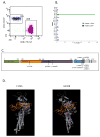Activating somatic mutations outside the SH2-domain of STAT3 in LGL leukemia
- PMID: 26419508
- PMCID: PMC4814354
- DOI: 10.1038/leu.2015.263
Activating somatic mutations outside the SH2-domain of STAT3 in LGL leukemia
Conflict of interest statement
H.R. has received honoraria from Novartis. S.M. has received honoraria and research funding from Novartis, Pfizer and Bristol-Myers Squibb.
Figures


References
-
- Sokol L, Loughran TP., Jr Large granular lymphocyte leukemia. Current hematologic malignancy reports. 2007;2(4):278–82. - PubMed
-
- Fasan A, Kern W, Grossmann V, Haferlach C, Haferlach T, Schnittger S. STAT3 mutations are highly specific for large granular lymphocytic leukemia. Leukemia. 2013;27(7):1598–600. - PubMed
Publication types
MeSH terms
Substances
Grants and funding
LinkOut - more resources
Full Text Sources
Other Literature Sources
Miscellaneous

